

by Bruce Cornet, Ph.D.
Table of Contents
Also illustrated in Volume 2 on the BUFOD website.
On 29 September 1995 Bruce Cornet planned on meeting David Ring from Florida at Stewart airport. Ring had wanted to see Pine Bush AOP, and Cornet agreed to take a couple days off to be his field guide. When Ring was not on the scheduled flight (he missed his plane and forwarded a message), Cornet decided to go out into the field alone until Ring's next flight. It took Cornet slightly more than two hours to drive up to the Wallkill River valley from Red Bank, NJ, and he didn't want to waste any time waiting three more hours at the airport.
So, Cornet drove to his standard observation location at the bend in West Searsville Rd., parked, and set up his camera. Below is a picture of Cornet standing where he set up his camera (taken on 18 December 1999). The area where performances typically took place is to the right of the new house in the distance. The Wilde farm house can be seen to the left of Cornet.
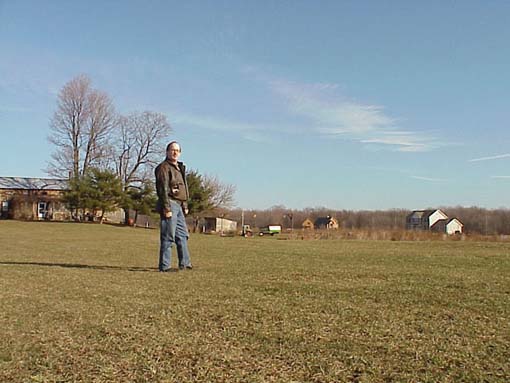
The time was 7:15 pm. He didn't have to wait long for something to show up. The timing of the Manta Ray's fly-by would have been perfect had Ring not missed his flight, because nothing happened after that performance. Ring went back to Florida empty handed and disappointed, blaming himself for his bad planning. In hind sight, Cornet had to wonder if other factors were involved in Ring missing his flight.
The highlight of Ring's trip was a stop of Pine Bush's famous barber shop, where he met Butch the barber (on the right below), who loves to relate local X-files-type stories.
|
Back to the data.
Sunset was at about 7:25 that evening. At 7:33 pm Cornet spotted a set of lights moving south about two miles east of his location. Because the lights were relatively low to the ground (the first indicator for AOP in the area), he began taking time exposures. His camera was firmly mounted on a stable tripod. He opened the shutter with an electronic cable switch to prevent shutter vibration. After the first time exposure he pointed his camera down direction for the next time exposure in sequence. Just after he opened the shutter the yellowish-white lights turned towards him and brightened considerably (the second indicator for AOP in the area). Their brightness was greater than that of aircraft landing lights, and there was an orangish haze or envelope around them (ionized atmospheric gases: see Plasma Orbs). Even more remarkable the craft began to move from left to right and then right to left, producing a fishtail or snaking movement through the air (the reason for the name of this page) without banking! The amount of lateral movement was considerable, indicating deliberate action by the pilot. The lights continued to come straight at him, climbing in altitude as they approached his position.
Time exposures 1-6.
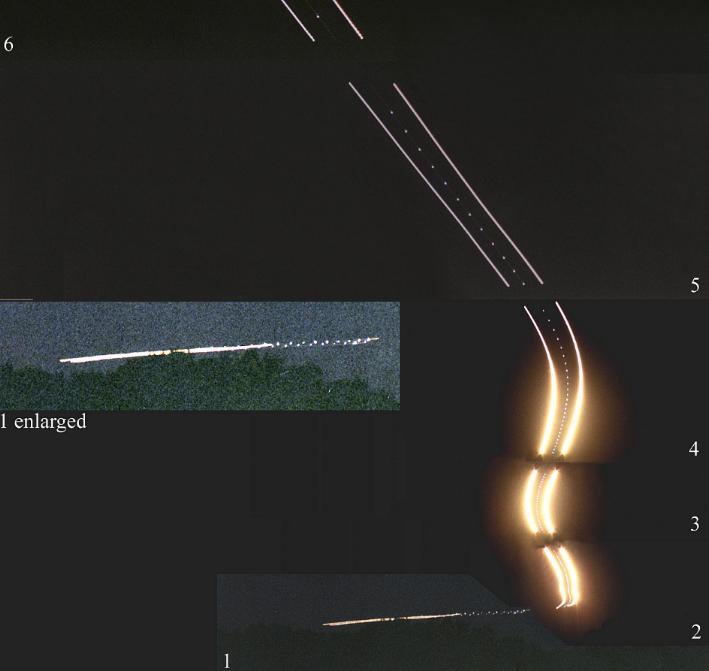
Images below compare 1) aircraft landing lights that produce a glowing aura due to mist or water vapour in the air and 2) the yellow-orange glowing aura created by the Manta Ray's lights when no mist was in the air. A small amount of mist was present when the first jetliner landed at Stewart International Airport, causing a small fog glow. The vapour trail from the engines of the first jetliner seem to ignite in an intense fog glow when the second jetliner passes through its wake. The main difference between the type of glow produced by the Manta Ray and that produced by the jetliners, aside from color, is the intensity of the landing lights (widths), which increase significantly for the Manta Ray during the glow phase, but do not increase very much in width for the jetliners. Therefore, a cause and effect relationship is implicated for the glow around the Manta Ray lights.
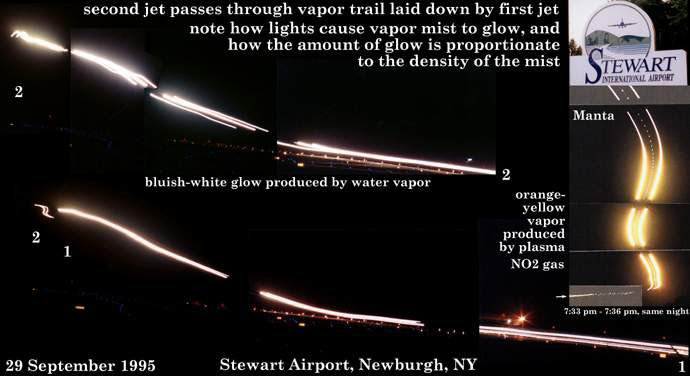
Enlargement:
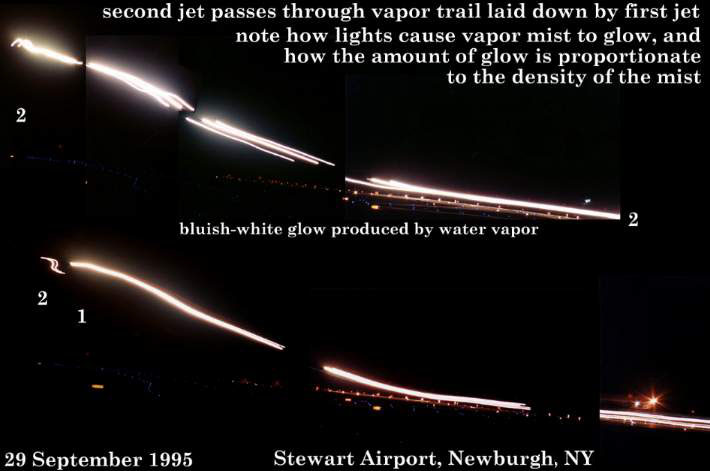
|
For the length of nearly three time exposures (77 seconds) the
pilot flared the craft's paired headlights (their position at the lateral margins of the
craft precludes them from being called landing lights) as "he" turned the craft
from left to right to left without banking. Near the beginning of time exposure #5 the first sound can be heard on the
audio tape. Up until that time there was no sound. As the craft continued its
approach, the sound grew louder and louder to the point that it vibrated the air around
Cornet as it flew over him. But the sound had an unfamiliar characteristic to
it. Instead of the pitch increasing according to the Doppler effect, it decreased
progressively (see spectrograms #1 and #3 below). Then, just as the craft passed
overhead, the sound quit for about a second, and Cornet's electronic camera stopped
working. Later he discovered that his audio recording shows a glitch where no sound
is recorded for a second, even though momentum of the tape motor and reels continued to
advance the tape. The sound from the craft came back on again, but it was now
different. It no longer resembled the sound of a jetliner, but resembled that of
high-pitch harmonic turbines. In addition, the volume of the sound decreased by
several orders of magnitude as the craft flew away from Cornet towards the west (spectrogram #2). When the camera stopped working (the electronic button would not open the shutter), Cornet hit the camera with his hand in frustration. The shutter opened, but the camera vibrated heavily from being hit. The picture captured on film (Time exposure #8) shows this vibration. The shape of the craft was that of the Manta Ray, although it was very difficult to make out its shape against the night sky due to plasma interference. After passing over Cornet, the Manta Ray began to descend rapidly. As it reached a low ridge to the west, it banked to the south and momentarily disappeared behind the highest point on that ridge. |
In order to do that its altitude had to be less than 300 feet (the peak it passed behind is only 260 feet above the valley floor). After it reached the ridge, the sound had abated to the point it could not be heard. From that time onward the Manta Ray flew silently. If sound had been produced, it should have been audible from a distance of one mile as it came through the gap in the ridge. The fact that the sound recorded varies from no sound to a thundering roar, and the sound volume was sharply reduced as the AOP flew over Cornet, indicates that the sound which was heard was not a normal product of engine noise.
For a comparison of the outline shape and
navigation lights of the Manta Ray to that of a DC-9 jetliner, click on thumbnail: 
Time exposures 6-7.
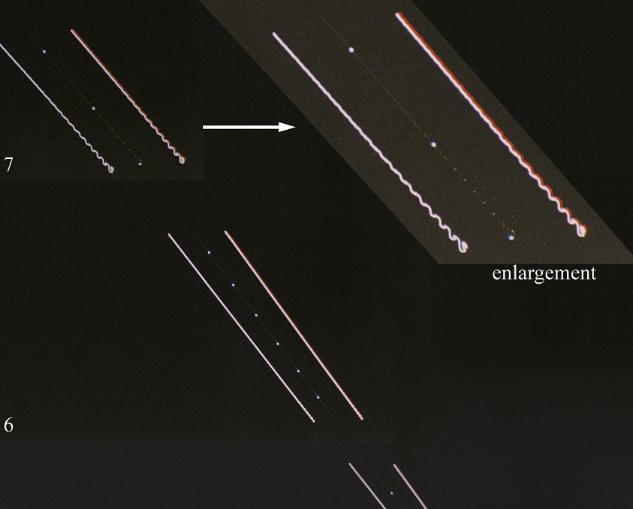
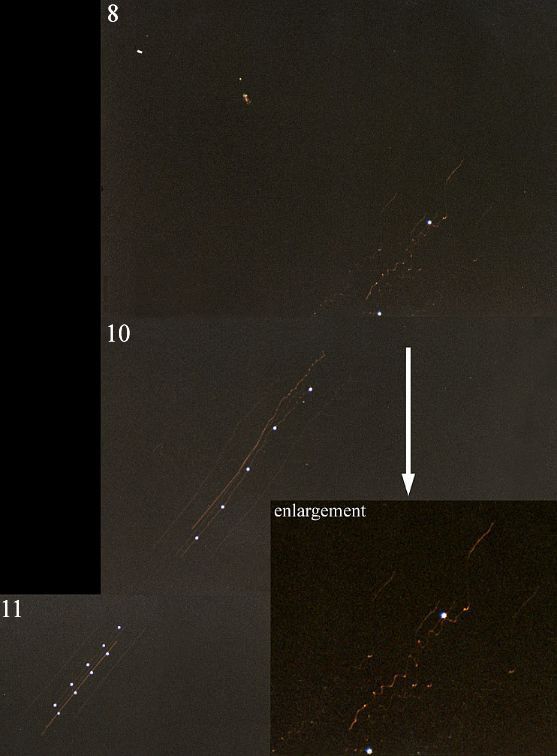
Below are the images showing the Manta Ray turning south before descending behind a low ridge (see map and images below).

Daytime picture of ridge behind West Searsville Rd. Picture taken from observation station or location.
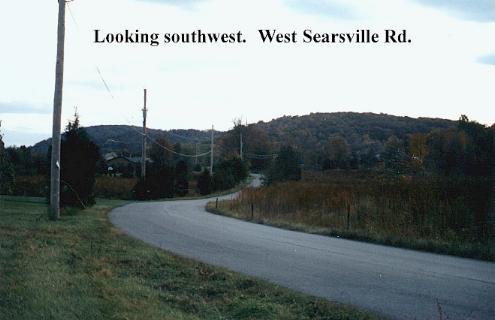
The Manta Ray reappeared over a break in the ridge or hill as it circled back towards the east. The path the Manta Ray took was so low it barely cleared the trees. Time exposure 14 shows how low the AOP was to the tree tops (segment with trees has been contrast enhanced). Time exposures 16-18 consistently show the AOP descending or dropping in altitude. Movement is from right to left.
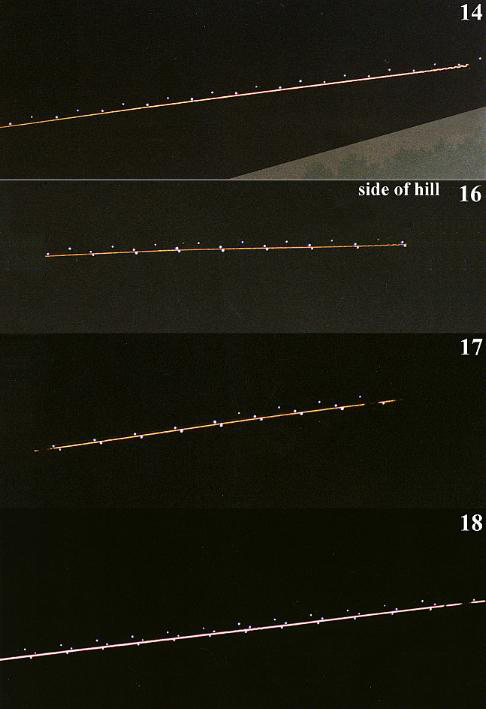
The following picture reconstructs the path of the Manta Ray as it briefly disappeared behind the highest part of the hill, came through a gap or saddle in the ridge, and then dropped in altitude as it traveled east back to its original flight path.
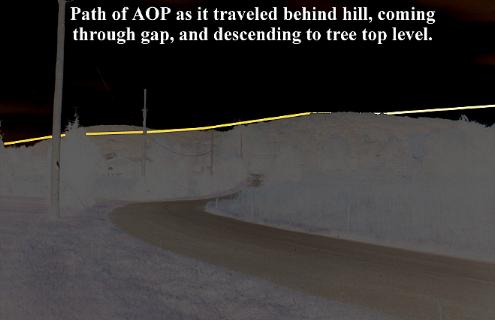
It continued east until it reached the point where it had turned towards Cornet, and then proceeded on its original course towards the south (see P2 flight path on map). Its average speed was calculated at 45 mph (39 knots).
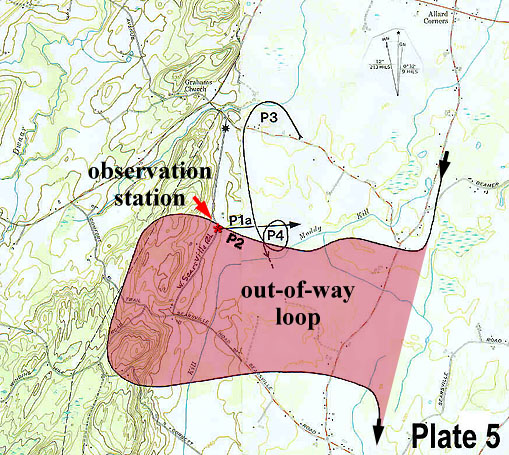
There is no mistaking this performance: The Manta Ray intentionally flew off course and circled around Cornet at low altitude as he stood on the ground, recording the event. No commercial pilot or military pilot without night vision equipment could have done this, and it is against all regulations, FAA or Military, for a pilot to buzz someone on the ground. In every respect, this performance qualifies as a high-tech aerobatic stunt. Only when the Manta Ray flew over Cornet was its altitude close to the minimum required by FAA regulations. At all other times this craft flew below radar detection.
FAA regulation 91.177 Minimum altitude for IFR operations. (a) Operation of aircraft at minimum altitudes. Except when necessary for takeoff and landing, no person may operate an aircraft under IFR below - (1) The applicable minimum altitudes prescribed in Parts 95 and 97 of this chapter; or (2) If no applicable minimum altitude is prescribed in those parts -- (i) In the case of operations over an area designated a mountainous area in part 95, an altitude of 2,000 feet above the highest obstacle within a horizontal distance of 4 nautical miles from the course to be flown; or (ii) In any other case, an altitude of 1,000 feet above the highest obstacle within a horizontal distance of 4 nautical miles from the course to be flown (AIM/FAR 1994 airman's information manual / federal aviation regulations).
FAA regulation 91.303 Aerobatic flight. No person may operate an aircraft in aerobatic flight -- (a) Over any congested area of a city, town, or settlement; (b) Over an open air assembly of persons. For the purposes of this section, aerobatic flight means an intentional maneuver involving an abrupt change in an aircraft's altitude, an abnormal altitude, or abnormal acceleration, not necessary for normal flight.
To play 9-29-5m4.wav (503K), click on Snaking Manta approach.
To play 9-29-5m4.ra (44K), click on RA version.
![]()
A Jet-like sound was played in reverse as Manta Ray approached camera. For another example of the reverse Doppler effect, see 9-10 August 1996 sightings. Note mid-point where camera jammed and sound volume is missing. The large spikes with red bases represent Cornet's voice as he called out shots and described what he saw and heard. Note the sudden drop in volume (top of graph) just before the mid-point (mid). Aircraft noise typically increases just after a noisy jet passes an observer, it doesn't decrease in volume!
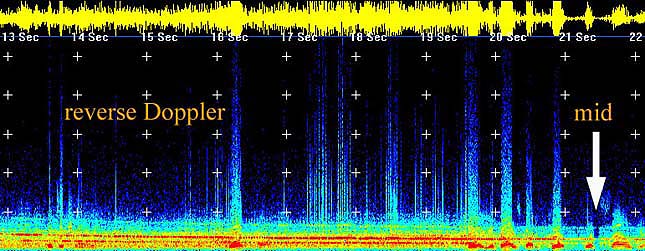
Harmonic turbine sound played as Manta Ray moved away from camera.
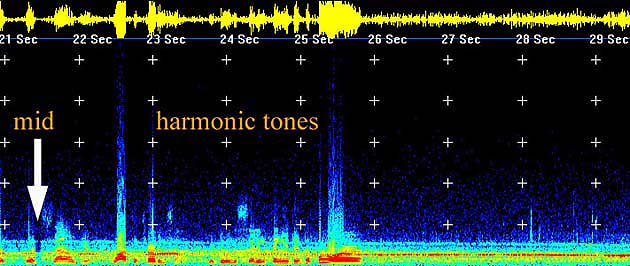
Spectrogram compressed (distorted) to shows reverse Doppler characteristics better. In order to explain this effect, which appears to violate a known law of physics, the sound was compared to that of a commercial jetliner taking off from an airport. The real jet sound was recorded and reversed or played backwards. Its reversed characteristics nearly match that of the recorded Manta Ray sound and drop in frequencies (in forward play frequencies increase as the jet's engines rev up to maximum thrust during take-off). But for the Doppler effect to be nullified, the synthetic frequencies broadcast from the Manta Ray had to have been adjusted downwards according to an algarithm so that the recorded curve would show no increase in frequency as the craft approached the microphone.
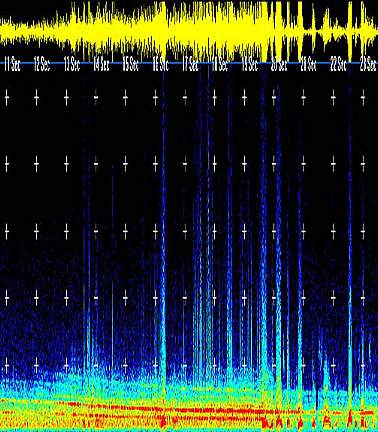
Frequency diagram of jet-like sound, which shows typical noise and fluctuations coming from a commercial jetliner, but lacks the highest frequencies (possibly filtered out before the sound was reversed and broadcast from the Manta Ray).
Direction of play: left to right.
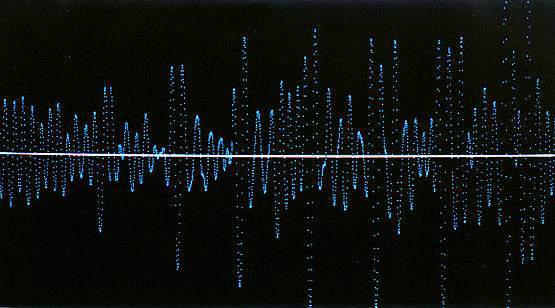
Frequency diagram of harmonic turbine sound that was produced after the Manta Ray passed the microphone. This sound is characteristic of synthetic sounds, and is also similar to what musical instruments produce.
Direction of play: left to right.
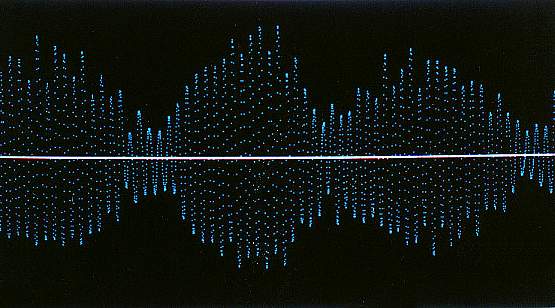
To play 9-29-5m5.wav (535K), click on Snaking Manta departure.
To play 9-29-5m5.ra (13K), click on RA version.
![]()
If this had been a conventional aircraft, what laws and/or regulations did the pilot break?
1) Flying below IRF minimum altitude.
2) Flying below FAA minimum altitude of 1,000 feet.
3) Flying an intentional maneuver involving an abrupt change in an aircraft's altitude, an abnormal altitude, or abnormal speed, not necessary for normal flight.
4) Generating sounds which are not normal for flight, and jamming electrical equipment on the ground.
What evidence is there that this aircraft had technology unavailable to all but the most top secret military projects?
1) Based on its size (300-400 feet wide by about 400 feet long) it was larger than a C5 military cargo plane, and yet could travel at an average speed of 45 mph (39 knots, or 1/3rd the stall speed of a C5, which is about 120 knots: C5 pilot, pers. comm. 1998)!
2) Most if not all commercial and military aircraft are not equiped with sound generating equipment, which can broadcast fake sounds.
3) All but the most advanced and tactical military aircraft lack equipment which can jam or affect electrical equipment on the ground.
4) No commercial or known military aircraft use plasmas for lights. The fact that the main lights of the Manta Ray can ionize the atmosphere precludes them from being classified as conventional lamps.
5) No commerical or known military aircraft is shaped like the Manta Ray.
6) All records by Cornet of the Manta Ray (see Index table of sightings) show essentially the same type of aircraft with the same style of navigation lights, which do not match that of known private, commercial, or military aircraft (aircraft which conform to aerodynamic laws and FAA regulations, that is).
The Westchester Wing and Manta Ray (if they are one and the same type of craft) are essentially high-tech light, sound, and shape-shifting platforms (see Another Performance) designed to confuse and disorient the "targets" (i.e. those on the ground). In that regard their design seems to have succeeded marvelously! Has someone found our Achille's heel? Or has the military decided to let its pilots parade their top secret aircraft before the public and unsecured cameras? Skeptics take notice. I've done my homework. Now it's your turn.
Copyright © 1999 Sirius Onion Works
Last modified: October 23, 2005